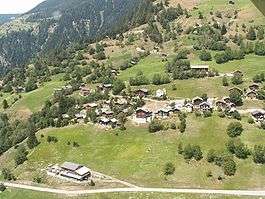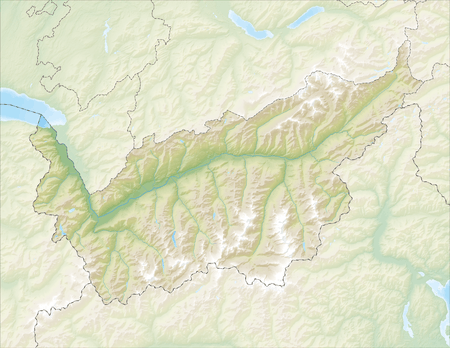Martisberg
Martisberg is a former municipality in the district of Raron in the canton of Valais in Switzerland. On 1 January 2014 the former municipalities of Martisberg and Betten merged into the new municipality of Bettmeralp.[1]
Martisberg | |
|---|---|
 | |
 Coat of arms | |
Location of Martisberg 
| |
 Martisberg  Martisberg | |
| Coordinates: 46°23′N 8°5′E | |
| Country | Switzerland |
| Canton | Valais |
| District | Raron |
| Area | |
| • Total | 3.0 km2 (1.2 sq mi) |
| Elevation | 1,367 m (4,485 ft) |
| Population (Dec 2011) | |
| • Total | 19 |
| • Density | 6.3/km2 (16/sq mi) |
| Postal code | 3994 |
| SFOS number | 6178 |
| Surrounded by | Betten, Grengiols, Lax |
| Website | SFSO statistics |
History
Martisberg is first mentioned in 1311 as Martisperg.[2]
Geography
Before the merger, Martisberg had a total area of 3.0 km2 (1.2 sq mi).[3] Of this area, 42.2% is used for agricultural purposes, while 41.2% is forested. Of the rest of the land, 3.7% is settled (buildings or roads) and 13.0% is unproductive land.[3]
The former municipality is located in the Östlich Raron district, on the northern slopes of the Rhone valley.
Coat of arms
The blazon of the municipal coat of arms is Or a Sword Azure hilted Sable inverted in bend sinistre covered with a cloth Gules in base Coupeaux Vert[4]
Demographics
Martisberg had a population (as of 2011) of 19.[3] As of 2008, about 9.1% of the population are resident foreign nationals.[5] Over the last 10 years (2000–2010 ) the population has changed at a rate of -26.7%. It has changed at a rate of 0% due to migration and at a rate of -20% due to births and deaths.[3]
All of the population (as of 2000) speaks German.[6]
As of 2008, the population was made up of 20 Swiss citizens.[5] Of the population in the municipality, 23 or about 85.2% were born in Martisberg and lived there in 2000. There were 4 or 14.8% who were born in the same canton but not in Martisberg.[6]
As of 2000, children and teenagers (0–19 years old) make up 25.9% of the population, while adults (20–64 years old) make up 48.1% and seniors (over 64 years old) make up 25.9%.[3]
As of 2000, there were 13 people who were single and never married in the municipality. There were 12 married individuals and 2 widows or widowers.[6]
As of 2000, there were 13 private households in the municipality, and an average of 2.1 persons per household.[3] There were 7 households that consist of only one person and households with five or more people. In 2000, a total of 13 apartments (32.5% of the total) were permanently occupied, while 21 apartments (52.5%) were seasonally occupied and 6 apartments (15.0%) were empty.[7]
The historical population is given in the following chart:[2][8]

Politics
In the 2007 federal election the most popular party was the CVP which received 70.68% of the vote. The next three most popular parties were the SP (14.29%), the FDP (9.02%) and the SVP (6.02%). In the federal election, a total of 19 votes were cast, and the voter turnout was 79.2%.[9]
In the 2009 Conseil d'Etat/Staatsrat election a total of 16 votes were cast, of which or about 0.0% were invalid. The voter participation was 94.1%, which is much more than the cantonal average of 54.67%.[10] In the 2007 Swiss Council of States election a total of 14 votes were cast. The voter participation was 77.8%, which is much more than the cantonal average of 59.88%.[11]
Economy
As of 2010, Martisberg had an unemployment rate of 0%. As of 2008, there were 4 people employed in the primary economic sector and about 2 businesses involved in this sector. No one was employed in the secondary sector or the tertiary sector.[3] There were 12 residents of the municipality who were employed in some capacity, of which females made up 25.0% of the workforce.
In 2008 the total number of full-time equivalent jobs was 2, both in agriculture.[12]
In 2000, there were 8 workers who commuted away from the municipality.[13] Of the working population, 8.3% used public transportation to get to work, and 66.7% used a private car.[3]
Religion
From the 2000 census, 26 or 96.3% were Roman Catholic and there was 1 individual who belonged to another church.[6]
Education
In Martisberg about 8 or (29.6%) of the population have completed non-mandatory upper secondary education.
As of 2000, there were 5 students from Martisberg who attended schools outside the municipality.[13]
References
- Nomenklaturen – Amtliches Gemeindeverzeichnis der Schweiz (in German) accessed 13 December 2014
- Martisberg in German, French and Italian in the online Historical Dictionary of Switzerland.
- Swiss Federal Statistical Office Archived 5 January 2016 at the Wayback Machine accessed 23 January 2014
- Flags of the World.com accessed 4 October 2011
- Swiss Federal Statistical Office - Superweb database - Gemeinde Statistics 1981-2008 Archived 28 June 2010 at the Wayback Machine (in German) accessed 19 June 2010
- STAT-TAB Datenwürfel für Thema 40.3 - 2000 Archived 9 August 2013 at the Wayback Machine (in German) accessed 2 February 2011
- Swiss Federal Statistical Office STAT-TAB - Datenwürfel für Thema 09.2 - Gebäude und Wohnungen Archived 7 September 2014 at the Wayback Machine (in German) accessed 28 January 2011
- Swiss Federal Statistical Office STAT-TAB Bevölkerungsentwicklung nach Region, 1850-2000 Archived 30 September 2014 at the Wayback Machine (in German) accessed 29 January 2011
- Swiss Federal Statistical Office, Nationalratswahlen 2007: Stärke der Parteien und Wahlbeteiligung, nach Gemeinden/Bezirk/Canton Archived 14 May 2015 at the Wayback Machine (in German) accessed 28 May 2010
- Staatsratswahlen vom 1. März 2009 (in German) accessed 24 August 2011
- Ständeratswahl 2007 (in German) accessed 24 August 2011
- Swiss Federal Statistical Office STAT-TAB Betriebszählung: Arbeitsstätten nach Gemeinde und NOGA 2008 (Abschnitte), Sektoren 1-3 Archived 25 December 2014 at the Wayback Machine (in German) accessed 28 January 2011
- Swiss Federal Statistical Office - Statweb Archived 4 August 2012 at Archive.today (in German) accessed 24 June 2010
| Wikimedia Commons has media related to Martisberg. |